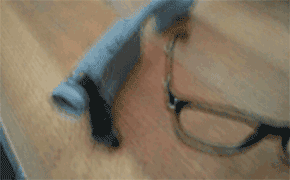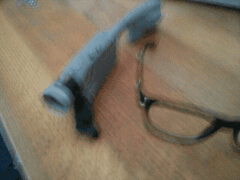
One of the common complaints about the Google Glass system is that it is “always on.” From the point of view of anyone not wearing one, the heads-up display unit looks like it could be on and recording at any point. This can be a bit unnerving. Tom Van de Crommert tackled this issue with his homemade head mounted display (HMD) by adding an elegant magnetic attaching mechanism. Now, when he’s not actively using the device, he can simply detach it and stow it in his pocket.
The simple attachment isn’t the only interesting part of this HMD. Van de Crommert built his wearable computer from scratch, starting with a Measy U2C android stick. This particular one was chosen because it has a composite video output, something he would need to drive his hacked Myvu display. It was also just the right size to be housed within the unit.
Van de Crommert set out to maintain a fairly high quality build. He didn’t want this to look like a bunch of electronics with exposed wires.
I saw other people building their own Google glasses but most of them were just small video displays attached to the glasses and the electronics were just connected with cables and wires, so it wasn’t really like Google Glass. I challenged myself to build my own Google Glass with all the electronic components on the side of the glasses, so no loose cables or wires.
Looking at the final product, it is easy to say that he met his goal. Another interesting fact is that the case is completely built using the 3Doodler, a 3D printing pen! He wrapped the circuit in a mesh and simply “drew” the case right onto it. He does note that if he had a chance to do this all over again, he would probably 3D print an actual case. It would likely make repairing the device much easier.
The 21 year old from the Netherlands started building this display in December of 2013, in his spare time. While he does have a degree in electronics, his day job is working with concrete molds, so that limited his time to spend on this project. The entire build ended up taking six months, but the results are quite impressive.
ADVERTISEMENT















